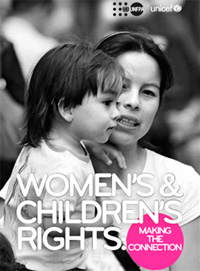News
Making the Connection: Building on the Synergies Between Women’s and Children’s Rights
- 25 February 2011
News
At a side event during the Commission on the Status of Women, UNFPA and UNICEF launched ‘Women’s and Children’s Rights: Making the Connection’, an advocacy booklet that explores how two strong treaties can complement each other in protecting the human rights of these two groups, with a focus on the rights of adolescent girls, child marriage, HIV and maternal mortality.
NEW YORK — Though the rights of children and mothers are inextricably linked, in our compartmentalized world, the rights of women and those of children have often been promoted in isolation from one another.
Separate international treaties and monitoring mechanisms have been created to protect the rights of the two groups, and specialized UN agencies, government ministries and non-governmental organizations focus on either women or children, but not usually both.
This can lead to tension between competing agencies and mandates, according to speakers at the CSW side event, who included Nafis Sadik, a former Executive Director of UNFPA, who now serves as Special Adviser to the UN Secretary-General and Special Envoy for HIV/AIDS in Asia and the Pacific; Stephen Lewis, Co-Director, AIDS-Free World; Marta Santos Pais, UN Special Representative of the Secretary-General on Violence against Children; and Fabiola, a 17-year-old youth advocate from Cameroon.
“Around children, you can gather all the energy and focus of the world,” said Mr. Lewis, contrasting the whole-hearted support for children to the “inherent misogyny with which the world deals with the vulnerability of women.
“The rights of women continue to take a backseat to the rights of children, specifically when it comes to addressing the AIDS problem,” Mr. Lewis said, according to UNICEF. “The emphasis in HIV/AIDS prevention is always on the life of the child. Women are seen as subsidiary. The focus should be equal on both child and mother.”
Ms. Sadik agreed that too often in the UN, two parallel processes compete for resources and attention. Yet there is great potential to work together to maximize impacts, she said, at the event, which brought together international leaders, policy makers and advocates, “We have to work together to find linkages, not just at the global level, but all the way down to the villages.”
On specific challenges that hinder collaboration, Dr. Sadik said UNICEF and UNFPA needed to work harder to instil women with a greater knowledge of their rights earlier in their lives. “Beginning with adolescents is already too late,” Ms. Sadik said. “You can’t empower women after the fact. You need to start with the child.”
A key entry point, she noted, is adolescent girls. “Empowerment of women has to begin with girls.”
As if to back up that point, Fabiola spoke eloquently about what she has seen in her home village. “Both the girl and boy have the right to be taken care of, but when it comes to education the girl is left behind. She may be forced into early marriage. Once married, she will be deprived of an education. Then, she has little say in how many children she might have. And she may die in childbirth.”
Education is the key, she said, because for a girl, “Educating herself is educating her family and her life to come.”
Ms. Pais pointed out that violence against women and children can be an important entry point to talking about protecting their shared rights. “It is the best opportunity to get exposure to the greatest inequalities, and to bring to the fore the consequences of unequal status,” she said.
Prior to the discussion, the panel got off to a rousing start with an example of the expressive energy of empowered young girls as Fabiola and a friend sang about their own experiences. “Every time I think about my rights, I feel good, good, good,” went the refrain.

Protecting women’s rights is important in itself but it also tends to reap benefits for their children, as clarified by the new publication, Making the Connection launched at the panel. Conversely, protecting the rights of children – particularly of those of girls – is the first step in promoting gender equality for women.
Advocating for women’s rights has been essential to advancing the situation of women worldwide. The same holds true for the promotion of children’s rights and improvements in their ability to thrive. However, if the rights of women and children are considered together, they can reinforce each other. Four key entry points for consolidating progress for both women and children include:
Adolescent girls: The publication highlights the need to address gender discrimination faced by adolescent girls, as this is crucial to their development and to the realization of their rights. The double burden of being both young and female relegates millions of adolescent girls to the margins of society where their rights are disregarded and their safety is denied.
Child marriage: More than 64 million women between 20 and 24 were married or in union before they were 18 years of age. The consequences can be devastating ranging from bonded labour or enslavement, to commercial sexual exploitation and violence.
HIV prevention: Even though access to HIV education, information, voluntary counselling and testing and related services was affirmed by the UN General Assembly in its 2006 Political Declaration on AIDS, women and girls have limited access to the institutions, resources and services that could strengthen their resilience in confronting the epidemic.
Maternal health: Maternal mortality was pointed out as one of the biggest threats to the rights of both women and children. The adverse effects of maternal mortality reverberate across a family and generations, diminishing prospects for surviving children.